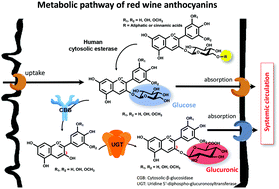Pharmacokinetics of table and Port red wine anthocyanins: a crossover trial in healthy men†
Abstract
This study was designed to evaluate the pharmacokinetics of Port and table red wine anthocyanins in healthy men. Volunteers were recruited to drink 250 mL of a table red wine (221 mg of anthocyanins) and 150 mL of young Port red wine (49 mg of anthocyanins). Venous blood was collected from participants at 0, 15, 30, 60 and 120 min after wine ingestion. Urine samples were collected at baseline and at 120 min. Anthocyanins and anthocyanin metabolites in plasma and urine samples were quantified by HPLC-DAD and tentatively identified by LC-MS. Red wine anthocyanins were detected in their intact forms in both plasma and urine samples, but the glucuronylated metabolites of peonidin and malvidin (PnGlucr and MvGlucr) were the two main derivatives detected after both red wine consumptions. For the first time, and supported by the synthesis of Mv3Glucr, the main pathway followed by Mv3glc after absorption was described and involves anthocyanidin conjugation with glucuronic acid after glucose removal. Despite the lower total content of anthocyanins ingested when volunteers drank Port wine, no differences were observed in the plasma Cmax of MvGlucr and PnGlucr after table and Port red wine consumption. The relative bioavailability of anthocyanins in Port wine was 96.58 ± 5.74%, compared to the anthocyanins present in red wine. In conclusion, both Port and table red wines are good sources of bioavailable anthocyanins.



 Please wait while we load your content...
Please wait while we load your content...